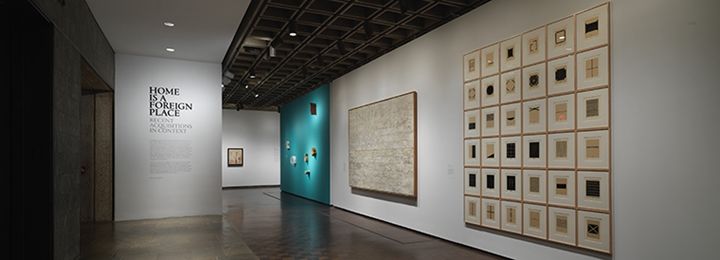Home Is a Foreign Place highlights recent acquisitions of modern and contemporary art from Latin America, the Middle East, North Africa, and South and Southeast Asia, alongside works by iconic modern American artists from The Met collection. Taking its title from Zarina's 1999 suite of thirty-six woodcuts, this exhibition features art that explores the meanings of "home" and "place" in our increasingly interwoven globe, whether by necessity or choice.

Contemporary art and earlier avant-garde movements of modern art do not have a single origin, nor do they develop in isolation. Since the 1940s, artists have sought new forms of expression as they have lived through culturally transformative events, from devastating wars, social and humanitarian injustices, and mass migration to economic and environmental change. These histories continue to impact and inform the art of our time. In this thematic display, works are united by shared engagements with language, architecture, space, and politics that demonstrate the movement of ideas and identities across cultural and national boundaries. The resulting visual conversations emphasize the significance of parallel artistic impulses in the world and over time, while remaining attentive to the specific local and historical circumstances of their making.

In the aftermath of tumultuous events such as World War II, the Partition of India in 1947, and the liberation movements and decolonization of the Global South over the following decades, artists often expressed ideas that deliberately countered the artistic conventions of the past. In the Cold War period, competing visions of modernity were sometimes characterized in oppositional terms: for instance, the propensity for either "abstraction" or "socialist realism" arising from capitalist and communist ideologies, respectively.
However, the various manifestations and methods of abstraction were in fact much more complex. Many artists from the newly independent nations of Asia and Africa traveled to Western cultural centers and developed practices that synthesized and expanded on the innovations of modernism. Conversely, some of their American and European counterparts found forms and ideas in traditional, premodern, or non-Western sources that unlocked new approaches to nonrepresentational art. For many, the rich formal and conceptual possibilities of language were of particular interest, allowing them to navigate the interstices between text and image. Consequently, works were reflective of their geographic origin yet also resonant with linguistic practices that transformed pictographs, characters, and cultural symbols into new means of abstraction.

Many artists working around the globe in the early 1970s were preoccupied with new artistic modes in which meaning in art was understood through our relationships to structure, place, and space. Some reduced these elements to their essential forms, drawing, molding, or replicating the walls, floors, and furnishings that bear traces of human presence. Others measured the area of the home, studio, or gallery with various materials—paint, tape, fabric, pencil, even the human body—literally marking out the rooms in which art is made and shown, thereby asserting the physical boundaries that define the aesthetic experience.
These concerns continue to occupy many contemporary artists in their focus on architectural interiors, external landscapes, and imagined spaces. Their works, produced in a range of techniques from casting to sanding to painting, investigate the complexities of place: its cultural significance, its emotional and often melancholic resonance, and its persistence in the absence of human occupation.

As artists embraced the conceit that an idea could attain the same status of art as an object, new practices developed across the world that questioned established methods and values of artistic production, circulation, consumption, and display. Creative strategies involving collaboration, the use of found objects, and nontraditional, local materials have served to challenge conventions of originality, authorship, and craft.
Some artists investigate space and acknowledge our bodily experience, making works that physically envelop the visitor or emphasize perceptual shifts. Others play with repetition. These artworks harness a distinctive aesthetic to comment on or undermine the commodification of the art object or gesture darkly toward social inequities due to economic changes.

In various ways, the avant-garde has used everyday objects or familiar images to both upend the established aesthetic order and critique the political and social status quo. With bold colors and imagery, Pop sensibility challenged traditional boundaries between so-called fine arts and popular culture, while Minimalism's logic-driven systems and seriality contested conventional notions of originality and craftsmanship.
Extending these legacies, contemporary artists have used similar strategies of co-option, adaptation, and destruction. In these works, they challenge systems of repression and subjugation, commenting subversively or ironically on topics such as the interdependence of politics and the media, the policing of sexuality and pleasure, the commodification of violence and warfare, and colonial oppression.

Economic and political forces in the wake of globalization have wrought unprecedented changes to contemporary cultures. Marked by fragmentation, migration, and mutation, these characteristically postmodern conditions have been reflected in artistic production from the 1970s to the present day, addressed in terms that range from purely formal to subversive to ironic. Seeking new ways to probe physical limits and conceptual possibilities in their work, some artists turned with renewed interest to collage and assemblage and embraced multimedia and new media practices. Whether exploring unconventional materials, often derived from their local environments (cardboard, rattan, electrical wire, and industrial detritus), or experimenting with narrative through text and video, artists today reckon with the often conflicting consequences of greater connectivity and the transnational flow of people, goods, and ideologies. The resulting work critically examines our histories and underscores the precarious nature of identity and belonging.
Donna Conlon (born United States, 1966). Coexistencia (Coexistence) (detail), 2003. Single-channel digital video, color, sound, 5 min., 26 sec. The Metropolitan Museum of Art, New York, Purchase, Latin American Art Initiative, 2017 (2017.703). © 2003 Donna Conlon